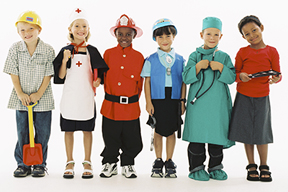Using Role Plays

Introducing Role Plays into the English Classroom
What is a role play?
A role play is when we get students to pretend to be someone else and to imagine that they are in a particular situation. The main aim of role plays is to provide freer speaking practice
Why should students pretend?
- It allows you to cover a wide range of topics.
- To practice various structures and vocabulary items.
- To feel more relaxed.
- To imitate real life communication.
Setting up role plays in class.
- The preparation stage.
These are the areas to be covered in this stage:
- Setting a context and teaching any necessary vocabulary. The context may be a reading or a listening text.
- Presenting and practicing language: Grammar, vocabulary and necessary phrases.
- Time to read the role. Remember to make the situation very clear before you distribute the role cards. Who are they? Parents and their children? A doctor and his patient? What is the situation? Maybe the son came home late, or the patient has an illness, or the teacher has to talk to the student about his bad marks. Then distribute the role cards. It is useful to check the students’ understanding of the roles. This can be done by asking basic comprehension questions. Eg. What time is it? How old is your son? How are you feeling?
- The practice stage.
Time to think of useful language and phrases. A pyramid discussion-type-task can be useful for this. First, students think of some useful language on their own, then they check this with a partner. Next, they work in a bigger group of three or four. Therefore, by the end of the discussion, they have a large phrase bank which they can use. They have had the support and received confidence from their classmates. This is very useful especially for shy or weak students.
- The role play.
We need to change the student pairings in this stage, and student A does the role play with student B. The teacher’s role here is to monitor, listening for examples of language use – both good examples and language that isn’t used correctly.
- Feedback.
Content feedback – a simple discussion on how the role play went. You could ask students for something that their partner said, or what the result of the role play was.
Language feedback – this is where you can show good examples of language that you heard, and also work on common language mistakes that happened during the role play.
